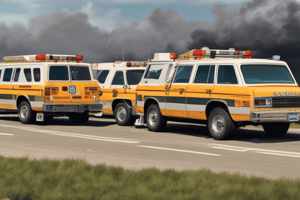Podcast
Questions and Answers
What are the primary responsibilities of the first arriving company officer at a multiple patient incident?
What are the primary responsibilities of the first arriving company officer at a multiple patient incident?
- Establish control over law enforcement
- Conduct a community assessment of needs
- Create a treatment area immediately
- Assume Command and give an on-scene report (correct)
When should Dispatch be notified about the type of incident and the condition of patients?
When should Dispatch be notified about the type of incident and the condition of patients?
- Only if additional resources are required
- As soon as possible after Command arrives (correct)
- After triage is completed
- When law enforcement arrives at the scene
What steps should be taken to ensure safety during the incident?
What steps should be taken to ensure safety during the incident?
- Position the response vehicle for visibility and use flares (correct)
- Systematically search for hazards after patients are treated
- Keep the area clear of all personnel and barricade the site
- Only rely on law enforcement for safety oversight
What does a Triage Report indicate after completion?
What does a Triage Report indicate after completion?
In a scenario with a high number of patients, what is a recommended action?
In a scenario with a high number of patients, what is a recommended action?
What are the roles of Dispatch during a multiple patient incident?
What are the roles of Dispatch during a multiple patient incident?
What is one effective method of treating patients when their number is limited?
What is one effective method of treating patients when their number is limited?
Which of the following is NOT a method for identifying treatment areas?
Which of the following is NOT a method for identifying treatment areas?
Study Notes
Incident Command
- First arriving company officer assumes Command and delivers an on-scene report addressing:
- Current situation
- Planned actions
- Required resources
Communication
- Inform Dispatch promptly about:
- Type of situation
- Approximate number of patients
- Patients' conditions
- Initial reports enable Dispatch to notify other agencies and medical facilities based on incident scale
Scene Assessment
- Command conducts a rapid scene survey to identify hazards and safety concerns.
- Establishes a safe zone utilizing:
- Defensive rig positioning
- Flashing lights
- Flare or reflector placement
Traffic Control
- Additional traffic control should be coordinated with law enforcement via Dispatch.
Assistance Requests
- Command must swiftly request further assistance if necessary.
- Dispatch responds based on:
- Assistance requests
- Progress reports from Command
Triage Process
- Triage is initiated early when patient numbers or injury severity exceed on-scene capacities.
- A Triage Report must be communicated to Alarm after triage is completed.
- Example of a Triage Report:
- “Triage to Command. Triage is complete. We have 9 total patients: 2 IMMEDIATES, 3 DELAYED, 4 MINORS.”
- Triage Reports help inform all responding crews about:
- Incident magnitude
- Need for additional resources
Treatment Strategies
- Determine the most effective approach for patient treatment quickly.
- For few patients, treatment may occur “in place.”
- For larger incidents, establish a designated treatment area.
- Use colored salvage covers:
- Red for IMMEDIATE
- Yellow for DELAYED
- Green for MINOR patients
Special Incident Considerations
- In cases like building collapses or hazardous material releases, removing victims to a safe area is preferred over stabilizing hazards.
- For complex incidents (train or bus collisions), triage will be performed at the treatment area entrance.
Studying That Suits You
Use AI to generate personalized quizzes and flashcards to suit your learning preferences.
Description
This quiz covers the protocols for the first arriving company officer at a multiple patient incident. It addresses how to assess the situation, communicate vital information to Dispatch, and ensure the safety of the scene. Learn key actions and resource management for effective incident command.



